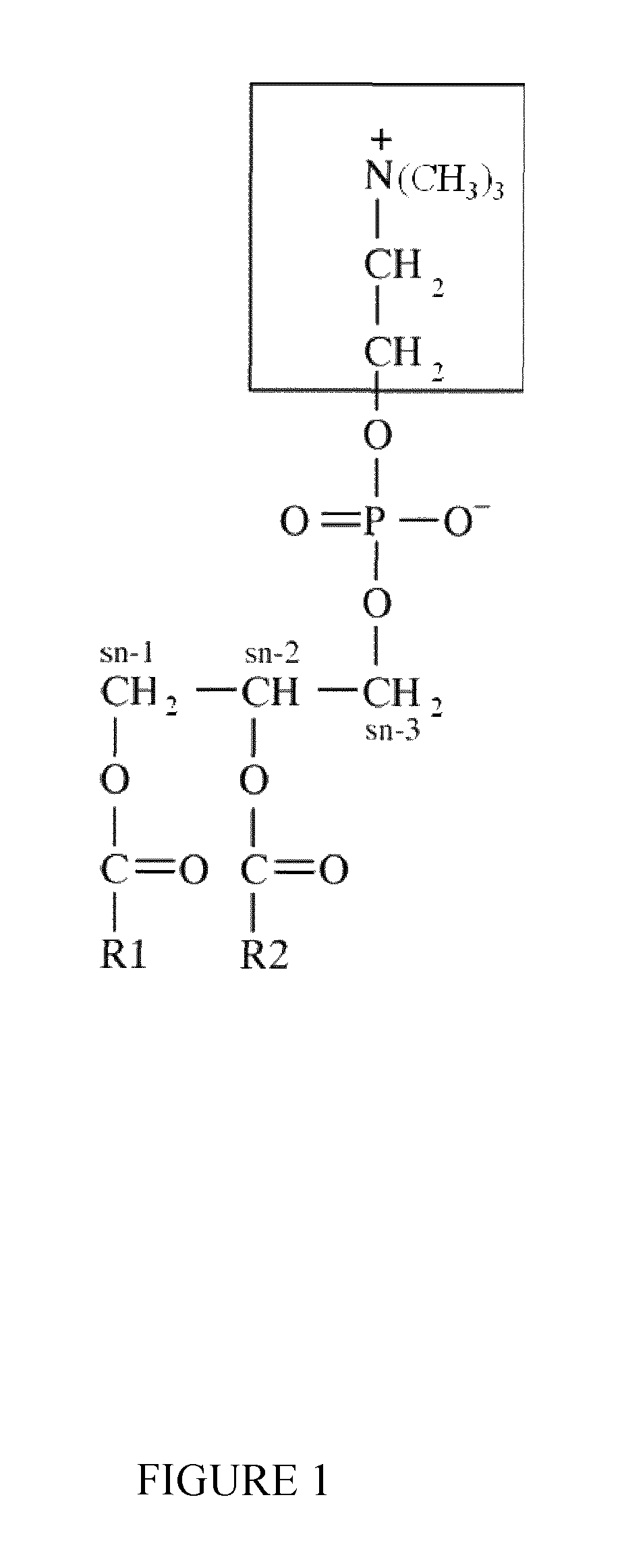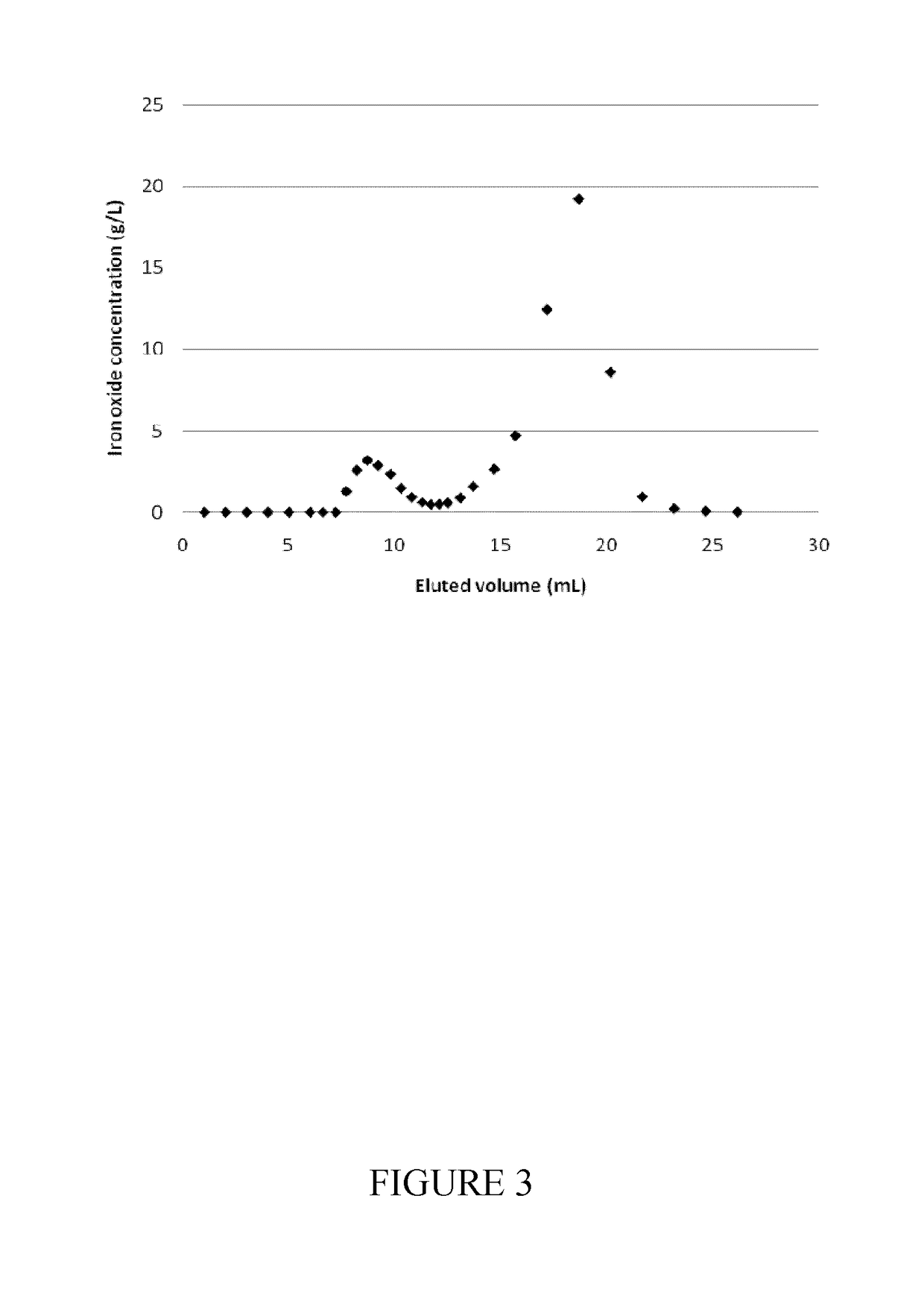Nanoparticles delivery systems, preparation and uses thereof
a technology of nanoparticles and delivery systems, applied in the direction of drug compositions, dispersed delivery, microcapsules, etc., can solve the problems of insufficient specificity, agent amount, and prevent the agent from achieving the therapeutic or diagnostic effect it is capable o
- Summary
- Abstract
- Description
- Claims
- Application Information
AI Technical Summary
Benefits of technology
Problems solved by technology
Method used
Image
Examples
example 1
on of 5 nm-Sized Nanoparticles
[0222]Iron oxide nanoparticles with a size distribution centered on 5 nm are synthesized by coprecipitation of ferrous and ferric ions adapted from U.S. Pat. No. 4,329,241 and Bacri et al., J. Magn. Magn. Mat., 1986, 62:36-46).
[0223]Briefly, the reacting medium, with controlled ionic strength, consists of a solution of sodium nitrate 3M maintained at pH 12. A 3M sodium nitrate solution of ferrous and ferric ions in a molar ratio Fe(III) / Fe(II) equal 2 is prepared and slowly added to the reacting medium under mixing. It rapidly turns black. The whole solution is then aged during one night at ambient temperature under mixing.
[0224]Ferrite nanoparticles are then sedimented on a magnet and the supernatant is removed in order to eliminate the reacting medium. Then peptization (acidification) and oxidation of the nanoparticles' surface is performed by diluting the pellet in a solution of nitric acid HNO3 2M at room temperature under vigorous mixing.
[0225]Oxid...
example 2
on of 30 nm-Sized Iron Oxide Nanoparticles
[0229]Iron oxide nanoparticles with a size distribution centered on 30 nm were synthesized by precipitation of ferrous ions followed by oxidation of the precipitate.
[0230]The aqueous reacting medium was maintained at pH 8 under continuous bubbling of nitrogen flow. A solution of ferrous chloride and a solution of sodium hydroxide were prepared and added simultaneously to the reacting medium. The solution turned green and highly turbid (“milky”).
[0231]Oxidation step was performed by adding H2O2 solution. The solution turned black, indicating the formation of the ferrite material. The nitrogen flow was removed after complete addition of H2O2. The ferrite nanoparticles were then aged during 2 h under stirring.
[0232]The ferrite nanoparticles were sedimented on a magnet to remove the supernatant. Peptization of the nanoparticles' surface with perchloric acid (HClO4) was performed by diluting the pellet in a solution of HClO4 1M.
[0233]Finally, pep...
example 3
reatment of Nanoparticles
3.1 Functionalization of Nanoparticles with Sodium Hexametaphosphate (HMP)
[0235]Suspension of sodium hexametaphosphate is added to the suspension of iron oxide nanoparticles from example 1 (the amount of sodium hexametaphosphate added being below LD50 / 5) and the pH of the suspension is adjusted to a pH comprised between 6 and 8.
[0236]Electronic surface charge (←20 mV) is determined by zeta potential measurements on a Zetasizer NanoZS (Malvern Instruments), using a 633 nm HeNe laser, performed on nanoparticle suspensions with concentrations varying between 0.2 and 2 g / L, the nanoparticles being suspended in an aqueous medium at a pH comprised between 6 and 8.
3.2 Functionalization of Nanoparticles with Silica
[0237]A first silica impregnation is performed by addition of sodium silicate in particle solution (7804, for 1 g particles from example 2 in 240 mL distilled water). Remaining sodium silicate is removed by a centrifugation against water. 125 mg particles ...
PUM
 Login to View More
Login to View More Abstract
Description
Claims
Application Information
 Login to View More
Login to View More - R&D
- Intellectual Property
- Life Sciences
- Materials
- Tech Scout
- Unparalleled Data Quality
- Higher Quality Content
- 60% Fewer Hallucinations
Browse by: Latest US Patents, China's latest patents, Technical Efficacy Thesaurus, Application Domain, Technology Topic, Popular Technical Reports.
© 2025 PatSnap. All rights reserved.Legal|Privacy policy|Modern Slavery Act Transparency Statement|Sitemap|About US| Contact US: help@patsnap.com



